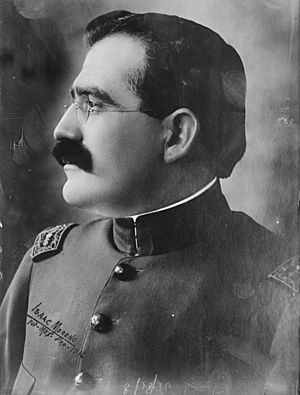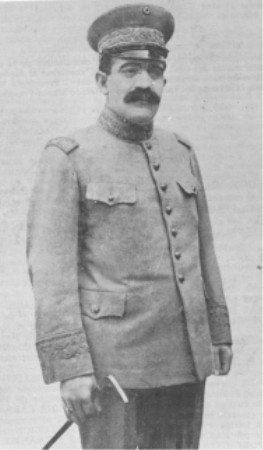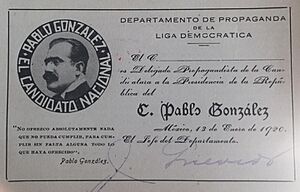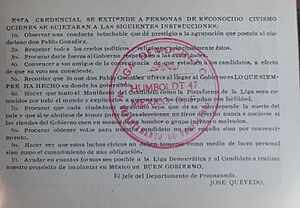Pablo González Garza facts for kids
Quick facts for kids
Pablo González Garza
|
|
|---|---|
 |
|
| Born | 5 May 1879 Lampazos de Naranjo, Nuevo León, Mexico |
| Died | 4 March 1950 (aged 70) Monterrey, Nuevo León, Mexico |
| Allegiance | |
| Service/ |
Maderistas (1911–12) Mexican Army (1912–13, 1914–20) Constitutional Army (1913–14) |
| Years of service | 1911–1920 |
| Rank | General |
| Commands held | Northeastern Corps (1913–14) |
| Battles/wars | Mexican Revolution |
Pablo González Garza (born May 5, 1879 – died March 4, 1950) was an important general during the Mexican Revolution. He is known for being the main person who planned the killing of Emiliano Zapata, another key figure in the revolution.
Contents
Early Life of Pablo González
Pablo González was born in Lampazos de Naranjo, Nuevo León, Mexico. He grew up in Nadadores, Coahuila, where his parents owned a store. Sadly, he became an orphan when he was only six years old. He later received a scholarship to the Military Academy in Chapultepec, but he chose not to finish his studies there. In his younger years, he worked in different jobs, like in a factory, on the railroad, and for an oil company. He worked in various places across northern Mexico and the southern United States.
Joining the Mexican Revolution
In 1907, Pablo González met Enrique Flores Magón, an anarchist, through his cousin. González joined Francisco Madero's fight against President Porfirio Díaz in 1911. His forces helped Madero by taking control of Monclova and Cuatro Ciénegas.
Later, in 1912, he fought against the rebellion led by Pascual Orozco. After Victoriano Huerta took power from Madero in a coup, González fought against both Huerta and Orozco in Coahuila. Even though he was seen as a rising military leader at the time, Orozco often defeated him in battles. This led to González being known as "the general who never won a victory." This reputation stayed with him for many years.
Working with Carranza
Later, Venustiano Carranza made him the chief of the Army of the Northeast. In 1914, González helped Carranza by taking control of important cities like Monterrey and Tampico. His capture of Monterrey, along with the Battle of Zacatecas, was very important in defeating Huerta, who then went into exile.
At the same time, Álvaro Obregón was put in charge of the Army of the Northwest, a position similar to González's. Obregón thought González was not a good general, which caused him to dislike Carranza. This dislike later led to more conflicts.
Fighting the Zapatistas
González was also given the job of calming the Zapatista rebellion in Morelos. This happened during the fights between Emiliano Zapata and Carranza. In this role, González gained a reputation for being very strict and harsh.
In his campaigns, González brought back an old practice of sending captured peasants to Yucatán. There, they were made to work very hard. To fight back against González, Zapata gave weapons to many villages, even those not directly under his control. This allowed the villagers to form their own defense groups. However, this plan later caused problems for Zapata. After González left, villagers sometimes used these weapons against Zapata's own groups when they were looking for food. This led to many fights between the villagers and Zapata's rebels.
For a while, González was quite successful in stopping the rebellion in Morelos. He got help from a Zapatista general named Sidronio Camacho, who had killed Zapata's brother, Eufemio Zapata. Camacho gave González important information. But after another revolt started in Coahuila, led by Lucio Blanco, González was called away. Zapata then managed to take back control of his home state.
Planning Zapata's Assassination
Pablo González was the main planner behind the killing of Emiliano Zapata. This act was carried out by one of González's colonels, Jesús Guajardo. In early 1919, González and Guajardo had some disagreements. When Zapata heard about these problems, he wrote a letter to Guajardo, asking him to join the Zapatistas.
González intercepted this letter. He used it to force Guajardo to help him set a trap for Zapata. Guajardo pretended to be loyal to Zapata by executing a Zapatista chief who had switched sides, Victoriano Bárcena. Then, Guajardo arranged a meeting with Zapata at the Chinameca Hacienda. He told Zapata he would deliver much-needed ammunition.
When Zapata arrived on April 10, 1919, a guard of honor greeted him. But on the third signal from a bugle, the guards opened fire at close range, killing Zapata.
Breaking with Carranza
In the 1920 election, President Carranza wanted a civilian named Ignacio Bonillas to be the next president. This made his generals, especially Álvaro Obregón, very unhappy because Obregón wanted to be president himself. When Carranza tried to arrest Obregón, Obregón started a military revolt.
At first, González stayed loyal to Carranza. However, most of the officers in his army supported Obregón and his ally, Plutarco Calles. They strongly opposed Bonillas. Because of this, González decided to run for president himself.
In April 1919, Carranza demanded that González stop his presidential campaign and fully support Bonillas. On April 30, González officially broke away from Carranza. Instead of arresting Carranza and taking over Mexico City (since most troops in the area supported González), he allowed Carranza to escape to Veracruz. González himself moved to nearby Texcoco.
During the time when Adolfo de la Huerta was interim president, González was accused of treason and rebellion and was arrested. He was first sentenced to be executed, but he was pardoned and instead went to live in exile in the United States.
Later Life
After Obregón won against Carranza and became president, González returned to Mexico. He stopped being involved in military life and politics and started a business. He lost almost all his money when his bank failed. Pablo González Garza died in 1950 in the city of Monterrey.
See also
 In Spanish: Pablo González Garza para niños
In Spanish: Pablo González Garza para niños




